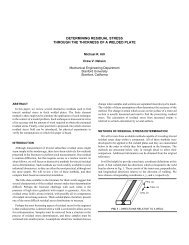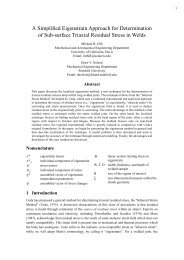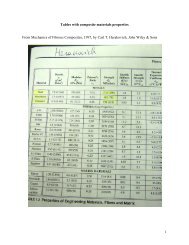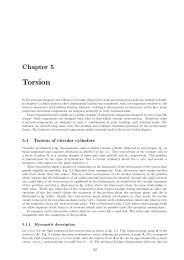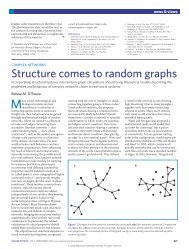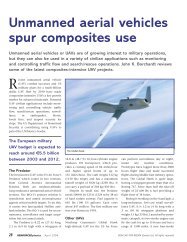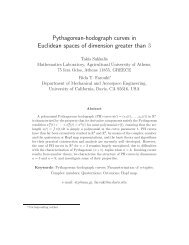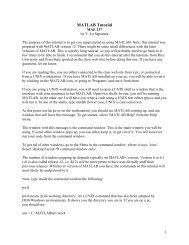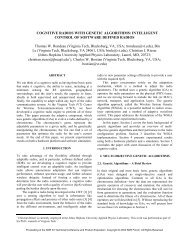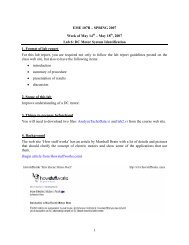Launch / Propulsion Group - Department of Mechanical and ...
Launch / Propulsion Group - Department of Mechanical and ...
Launch / Propulsion Group - Department of Mechanical and ...
Create successful ePaper yourself
Turn your PDF publications into a flip-book with our unique Google optimized e-Paper software.
<strong>Launch</strong> <strong>and</strong> Space <strong>Propulsion</strong><br />
By:<br />
Karen Au, Forrest Edwards, Eric<br />
Han, Nick Giannini, Gordon Liao,<br />
Matthew M<strong>and</strong>eville, Jr., Vincent<br />
Wong
<strong>Launch</strong>time
INTRODUCTION!!!!!!!!!!!!!<br />
Background<br />
Fuels<br />
Typical Heavy lifters<br />
Typical Medium <strong>and</strong> Light lifters<br />
Space <strong>Propulsion</strong><br />
Current Missions<br />
Conclusion
Background<br />
First pioneers in launch were Konstantin<br />
Tsiolkovsky <strong>and</strong> Robert Goddard in the early 20th<br />
century.<br />
Goddard built the first liquid fueled rocket in 1926<br />
From there rockets evolved to the weapons <strong>and</strong><br />
means <strong>of</strong> transportation that they are today.
How Rockets Work<br />
Rockets push against themselves by expulsion <strong>of</strong> exhaust<br />
gas, a concept many earlier critics could not grasp.<br />
They are currently fueled by solid, monopropellant <strong>and</strong><br />
bipropellant liquids.<br />
The power <strong>of</strong> a rocket is measured in its specific impulse,<br />
Isp. This is a relation <strong>of</strong> thrust to exhaust flow.<br />
Escape velocity is about 7 miles per second.
How Rockets Work<br />
A solid fuel rocket stores fuel in a solid form,<br />
typically powdered aluminum with aluminum<br />
perchlorate as an oxidizer.<br />
Safer, easier <strong>and</strong> cheaper<br />
Can not be stopped or adjusted on the fly,<br />
typically lower performance <strong>and</strong> thrust. (Isp is<br />
between 285 <strong>and</strong> 292)
How Rockets Work<br />
Monopropellant liquid fuel rockets use a<br />
fuel, typically hydrazine, that breaks down<br />
on contact with a catalyst to produce thrust.<br />
Typically used in attitude <strong>and</strong> velocity<br />
control because <strong>of</strong> its excellent h<strong>and</strong>ling<br />
characteristics <strong>and</strong> clean exhaust products,<br />
as well as its reusability.
How Rockets Work<br />
Liquid bipropellant rockets work by mixing an oxidizer<br />
<strong>and</strong> a fuel in a combustion chamber.<br />
Flowing fuel typically also powers a turbine that pumps<br />
more fuel into the engine.<br />
Provides higher thrust than solid fuels. Isp ranges from 310<br />
to 446 seconds.<br />
Chemicals that power liquid rockets can be dangerous to<br />
store or use.
Fuels
LOX (Liquid Oxygen)<br />
Features:<br />
Earliest, safest, cheapest; preferred oxidizer<br />
Drawback – Moderately cryogenic<br />
Transparent light blue color, no odor.<br />
LOX does not burn but will support combustion<br />
vigorously.<br />
Liquid is stable, but mixture <strong>of</strong> LOX <strong>and</strong> fuel is shock<br />
sensitive.<br />
Obtained from air by fractional distillation<br />
By 1980, $0.08 per kg
Kerosene<br />
1954 st<strong>and</strong>ard US kerosene rocket furl RP-1.<br />
Russian kerosene (T-1, RG-1), 1980 Sintin synthetic<br />
kerosene.<br />
RP-1 straight-run kerosene fraction that subject to further<br />
treatment. (detail refer to article)<br />
Flash point 43 deg Celsius (above 43 deg will form<br />
explosive mixture with air)<br />
Temperature range for explosive mixture is 79-85 (rich<br />
limit)<br />
By 1980’s, $0.20 per kg<br />
Russian formulation has physical densities <strong>of</strong> 0.82-0.85<br />
g/cc
LH2 (Liquid Hydrogen)<br />
Theoretically ideal rocket fuel<br />
Drawbacks: highly cryogenic, very low density<br />
U.S. mastered hydrogen technology for highly classified<br />
Lockheed CL-400 in mid 1950’s.<br />
99.79% parahydrogen <strong>and</strong> 0.21% orthohydrogen.<br />
Boiling pt. 253 deg Celcius.<br />
Transparent w/o odor.<br />
Not toxic, but extremely flammable.<br />
Flammable limit is 4-75 volume percent<br />
1980’s, $3.60 per kg
How to Get From Planet to<br />
Planet<br />
Hohmann vs. Direct vs. “Slingshot”<br />
Hohmann orbits are the most economical, but<br />
<strong>of</strong>ten the longest.<br />
A Hohmann orbit is the gradual change <strong>of</strong> a space<br />
craft from Earth’s orbit to the Mars’ orbit.<br />
Direct straight line routes require too much fuel.<br />
Slingshot orbits are most imperative for<br />
expeditions to the sun, <strong>and</strong> rely on “slingshotting”<br />
<strong>of</strong>f <strong>of</strong> a celestial body’s gravity pull.
Heavy Lift <strong>Launch</strong> Vehicles
Long March Family
CZ-NGLV CZ NGLV-540 540<br />
Heavy <strong>Launch</strong> Vehicle<br />
LEO Payload > 11,340 kg
Stage 1.4x CZ-NGLV CZ NGLV-200 200<br />
Engine: YF-120t (Development stage)<br />
Gross Mass: 69,000 kg<br />
Empty Mass: 6,000 kg<br />
Thrust(vac): 136,660 kgf<br />
Isp: 336 sec.<br />
Isp(sea level): 301 sec<br />
Burn time: 150 sec<br />
Diameter: 2.25 m<br />
Span: 4.60 m<br />
Length: 25.00 m<br />
Propellants: Lox/Kerosene
YF-120t YF 120t<br />
Designer: China Academy <strong>of</strong><br />
Aerospace Liquid <strong>Propulsion</strong><br />
Technology.<br />
Developed in: 1999-2006.<br />
Used on stages: CZ-NGLV-2-1,<br />
CZ-NGLV-3-1.<br />
Used on launch vehicles: CZ-<br />
NGLV-Light, CZ-NGLV-<br />
Medium, CZ-NGLV-A, CZ-<br />
NGLV-B, CZ-NGLV-C, CZ-<br />
NGLV-D, CZ-NGLV-E, CZ-<br />
NGLV-F.<br />
Propellants: Lox/Kerosene<br />
Isp: 336 sec.<br />
Isp (sea level): 301 sec.<br />
Chambers: 1.<br />
Country: China.<br />
Status: In development.
Stage 2.1x CZ-NGLV CZ NGLV-500 500<br />
Engine: YF-50t (Development stage)<br />
Gross Mass: 175,000 kg<br />
Empty Mass: 17,000 kg<br />
Thrust(vac): 142,760 kgf<br />
Isp: 432 sec.<br />
Isp(sea level): 333 sec<br />
Burn time: 480 sec<br />
Diameter: 5.00m<br />
Span: 5.00 m<br />
Length: 31.00 m<br />
Propellants: Lox/LH2
YF-50t YF 50t<br />
Designer: China Academy <strong>of</strong><br />
Aerospace Liquid <strong>Propulsion</strong><br />
Technology.<br />
Developed in: 1999-2006.<br />
Used on stages: CZ-NGLV-5-1.<br />
Used on launch vehicles: CZ-<br />
NGLV-A, CZ-NGLV-B, CZ-<br />
NGLV-C, CZ-NGLV-D, CZ-<br />
NGLV-E, CZ-NGLV-F.<br />
Propellants: Lox/LH2<br />
Isp: 432 sec.<br />
Isp (sea level): 333 sec.<br />
Chambers: 1.<br />
Country: China.<br />
Status: In development.
Dimension: CZ-NGLV CZ NGLV-540 540<br />
Core Stage<br />
Diameter: D = 5.0 m<br />
Strap-ons:<br />
Diameter: D = 2.25 m (x4)<br />
Core:<br />
Diameter: D = 5.00 m<br />
Total length: L = 55.0 m<br />
Span: 11.00 m
CZ-NGLV CZ NGLV-540 540 Performance<br />
LEO Payload: 10,000 kg<br />
Orbit: 200 km orbit at 52 degrees<br />
Lift<strong>of</strong>f Thrust: 596,000 kgf<br />
Lift<strong>of</strong>f Thrust: 5,840.00 kN<br />
Total Mass: 470,000 kg<br />
Core Diameter: 5.00 m<br />
Total Length: 55.00 m<br />
Span: 11.00 m
CZ-NGLV-522<br />
Other Variants<br />
• 2 x 2.25 m <strong>and</strong> 2 x 3.35 m strap-on<br />
stages<br />
• 3.35 m strap on stages give launch<br />
vehicle extra boost.<br />
Stage 1.2 x CZ-NGLV-300<br />
Engine: YF-120t (Development stage)<br />
Gross Mass: 147,000 kg<br />
Empty Mass: 12,000 kg<br />
Thrust(vac): 273,320 kgf<br />
Isp: 336 sec.<br />
Isp(sea level): 301 sec<br />
Burn time: 150 sec<br />
Diameter: 3.35 m<br />
Span: 4.60 m<br />
Length: 26.30 m<br />
Propellants: Lox/Kerosene<br />
CZ-NGLV-522 CZ-NGLV-540
DELTA 4
History<br />
-Latest class among the long history <strong>of</strong> DELTA rockets<br />
Introduced in 2001, Heavy model introduced in 2003<br />
History<br />
First started from Thor ICBM, developed in the mid-1950s for the U.S. Air Force<br />
1st launch on 11/20/02 with MED PLUS 4,2 Eutelsat W5 satellite, Successful Nov 20, 2002<br />
<strong>Launch</strong>ed 3 so far, all successful with high accuracy<br />
Improvements from previous <strong>and</strong> new updated improvements<br />
New low-cost cryogenic booster engine<br />
Common booster core<br />
Consolidated manufacturing <strong>and</strong> launch operations facilities<br />
Parallel <strong>of</strong>f-pad vehicle <strong>and</strong> payload processing<br />
Simplified horizontal integrate, erect, <strong>and</strong> launch concept
Types
Types<br />
3 classes, 5 types<br />
Medium<br />
uses 1 Common Booster Core (CBC)<br />
CBC is 5m in diameter<br />
Medium plus has 3 types<br />
1 st number means the diameter <strong>of</strong> the fairing, 2 nd number means the number <strong>of</strong> solid rocket<br />
motors (SRM)<br />
(4,2) has 4m diameter fairing with 2 SRMs<br />
(5,2) has 5m diameter fairing with 2 SRMs<br />
(5,4) has 5m diameter fairing with 4 SRMs<br />
Heavy<br />
has 5m diameter fairing with an option <strong>of</strong> using composite fairing or aluminum isogrid<br />
fairing<br />
instead <strong>of</strong> SRMs uses 2 more strap-on CBCs as liquid rocket boosters (LRB)<br />
first launch expected in summer <strong>of</strong> 2004
Fairing<br />
has 3 sizes (4 types)<br />
1. 4-m diameter used by Medium <strong>and</strong><br />
Medium Plus (4,2) 11.7m tall<br />
2. 5-m diameter used by Medium Plus<br />
(5,2) <strong>and</strong> (5,4) 14.3m tall<br />
3. 5-m diameter used by Heavy<br />
(composite) 19.1m tall<br />
4. 5-m diameter used by Heavy, made <strong>of</strong><br />
aluminum isogrid 19.8 tall<br />
Fairing
Engine<br />
Uses Boeing Rocketdyne RS-68 for CBC using<br />
liquid hydrogen <strong>and</strong> liquid oxygen<br />
Produces 2891 kN <strong>of</strong> thrust<br />
RS-68 is environmentally friendly, producing<br />
only steam as a combustion by-product<br />
Specific impulse : 410sec
Secondary Engines<br />
Solid Rocket Motors (SRM)<br />
Manufactured by Alliant Techsystems <strong>and</strong> designated as graphite-epoxy motors<br />
(GEM-60)<br />
1.55m diameter<br />
Burns out <strong>and</strong> jettisoned <strong>of</strong>f in the first stage<br />
2 nd stage starts 4.5 mins after lift<strong>of</strong>f<br />
Uses Pratt & Whitney RL10B-2 engine<br />
Thrust: 24,750 lb<br />
Weight: 664 lb<br />
Fuel/oxidizer: LH 2 /LO 2<br />
multiple firing <strong>and</strong> restarts<br />
Specific impulse: 465.5 sec
Medium<br />
Medium plus<br />
Heavy<br />
Payload<br />
4,210 kg<br />
5,845kg (4,2)<br />
4,640kg (5,2)<br />
6,565kg (5,4)<br />
13,130 kg
ATLAS
Made from Lockheed Martin<br />
First designed as ICBM<br />
First flight <strong>of</strong> ATLAS II in 1991<br />
Now over 550 Atlas missions<br />
History/Background
ATLAS III<br />
Introduced in 2003<br />
Has IIIA <strong>and</strong> IIIB<br />
thrust 4,500kg GTO<br />
Improvements:<br />
uses RD-180 engine, liquid oxygen <strong>and</strong> kerosene, <strong>and</strong> is Russian designed
Made jointly by Russia <strong>and</strong> Pratt &<br />
Whitney<br />
Powers both Atlas III <strong>and</strong> V<br />
Fuel = LOX/ RP-1<br />
Thrust = sea level 3,820 kN<br />
vacuum 4,142 kN<br />
Specific impulse = sea level 311 s<br />
vacuum 337 s<br />
Mixture ratio = 2.6 : 1<br />
You’ll hear more on this later.<br />
RD-180 RD 180
ATLAS V<br />
Introduced in 2002<br />
Has four types: 300, 400, 500, <strong>and</strong> heavy series<br />
thrust 8,200 kg GTO<br />
RD-180 Common Core Booster plus five strap on booster
Upper Stage<br />
Centaur<br />
powered by two Pratt & Whitney RL-10 turbopump-fed engines<br />
LOX/LH2<br />
Atlas IIs<br />
uses 2 RL-10s<br />
thrust 198.4 kN<br />
Atlas IIIA<br />
IIIA - uses 1 RL10A-4-1 (99kN)<br />
IIIB – extended 1.68m, uses either one or two<br />
RL10A-4-2 with 99.2 kN thrust each<br />
Atlas V<br />
identical to Centaur stage on IIIB<br />
Inertial navigation unit (INU) located on Centaur that provides guidance <strong>and</strong> navigation both<br />
Atlas <strong>and</strong> Centaur<br />
Multiple restarts possible
All use LOX/LH2, restart available<br />
Thrust<br />
Specific impulse<br />
Vehicles Used<br />
RL-10A-3-3A<br />
73.2 kN<br />
444.4 s<br />
Titan <strong>and</strong> Atlas<br />
Centuar<br />
RL-10 Engines<br />
RL-10A-4<br />
92.5 kN<br />
449 s<br />
Atlas II<br />
RL-10A-4-1<br />
99.2 kN<br />
451 s<br />
Atlas IIAS, III, V<br />
RL-10B-2<br />
109.8 kN<br />
464 s<br />
Delta III & V
Russian <strong>Launch</strong> Vehicles
Why Proton & Energia<br />
Proton is typical is on the High end <strong>of</strong> what<br />
are currently considered to be Heavy Lift<br />
<strong>Launch</strong> Vehicles. Provides a good<br />
comparison <strong>of</strong> what is “available now”.<br />
Energia is the only currently “available”<br />
launch platform that comes close to the<br />
Mars DRM/Direct/ChemA-B missions.
200000<br />
180000<br />
160000<br />
140000<br />
120000<br />
100000<br />
80000<br />
60000<br />
40000<br />
20000<br />
0<br />
'99 DRM: 6 @ 80mt<br />
Gross Payload to LEO capability<br />
'92 DRM: 3 @ 200mt<br />
'90 Direct: 2 @ 120mt<br />
'99 Chem-AB: 8 @ 80mt<br />
Ariane 5G Long March 3B Proton Space Shuttle Zenit 2 Zenit 3SL Shuttle-C Delta IV heavy Energia
•3 & 4 stage variants<br />
Proton-- Proton--Overview<br />
Overview<br />
•Proton-K/M is largest version<br />
•21,000kg LEO<br />
Proton <strong>Launch</strong> System Mission Planner’s Guide, LKEB-9812-1990
•Stage1<br />
•RD-0252 Engines (x6)<br />
Proton<br />
•NTO: nitrogen tetroxide (N 2 O 4 )<br />
•Stored in central tank<br />
•UDMH: unsymmetrical<br />
dimethalhydrazine<br />
•Stored in 6 outboard tanks<br />
•Sea level thrust: 9.5 MN<br />
•Vacuum thrust: 10.5 MN<br />
•ISP 316sec<br />
Proton <strong>Launch</strong> System Mission Planner’s Guide, LKEB-9812-1990
•Stage1<br />
•Weight data<br />
Proton<br />
•Empty Weight: 31,000 kg<br />
•Propellant Weight: 419,410 kg<br />
Proton <strong>Launch</strong> System Mission Planner’s Guide, LKEB-9812-1990
•Stage 2<br />
•RD-0210 Engines (x4)<br />
•Same fuel as Stage 1<br />
•Vacuum thrust: 2.3 MN<br />
•Empty Weight: 11,750kg<br />
Proton<br />
•Propellant Weight: 156,113kg<br />
Proton <strong>Launch</strong> System Mission Planner’s Guide, LKEB-9812-1990
•Stage 3<br />
•RD-0210 Engines (x1)<br />
Proton<br />
•Same fuel as Stage 1&2<br />
•Vacuum Thrust: 583 kN<br />
•Four-Nozzle Vernier engine<br />
•Vacuum Thrust: 31 kN<br />
•Empty Weight: 4185 kg<br />
•Propellant Weight: 46,562 kg<br />
Proton <strong>Launch</strong> System Mission Planner’s Guide, LKEB-9812-1990
Proton<br />
•Stage 4– Two Possiblities<br />
•Block DM 4 th Stage<br />
•11D58M (x1)- Gimbaled<br />
•LOX / Kerosene<br />
•NTO / UDMH Attitude Control<br />
•Vacuum Thrust: 83.5 kN<br />
•Restartable (7x)<br />
•Empty Weight: 2440 kg<br />
•Propellant Weight: 15,050 kg<br />
Proton <strong>Launch</strong> System Mission Planner’s Guide, LKEB-9812-1990
•Stage 4– Two Possiblities<br />
•Breeze/M 4 th Stage<br />
•Main Engine 14D30<br />
•19.62 kN<br />
•Impulse Adj. Thrusters 11D48 (x4)<br />
•396 N<br />
•Attitude Control 17D58E (x12)<br />
•13.3 N<br />
•Restartable (8x)<br />
Proton<br />
Proton <strong>Launch</strong> System Mission Planner’s Guide, LKEB-9812-1990
•SMAD Table 18.2 Pg 727<br />
Proton-- Proton--Statistics<br />
Statistics<br />
•Relaibility: 0.931 (216 / 232)<br />
•<strong>Launch</strong>es since failure: 41<br />
•Avg Downtime 4 Months<br />
•Cost per kg to LEO $4302<br />
http://www.futron.com/pdf/Futron<strong>Launch</strong>Cos<br />
tWP.pdf
•SMAD Table 18.2 Pg 727<br />
Proton-- Proton--Statistics<br />
Statistics<br />
•Relaibility: 0.931 (216 / 232)<br />
•<strong>Launch</strong>es since failure: 41<br />
•Avg Downtime 4 Months
Energia<br />
http://www.russianspaceweb.com/energia.html
•Payloads mounted laterally<br />
Energia<br />
•As shown: 6.7m diameter, 30m length<br />
•Compare to Delta IV heavy w / 5m fairing:<br />
•1.8m diameter, 4.8m length<br />
•Delta Payload fairing shown inset in<br />
Energia fairing.<br />
Payload to LEO 88,000-100,000 kg<br />
http://www.energia.ru/english/energia/launchers/vehicle_energia.html
•Engines – Stage 0<br />
•RD-170 Strap-On (x4)<br />
•LOX / Kerosene<br />
•Vacuum thrust: 7.9 MN / engine<br />
•Empty Weight: 35,000kg<br />
•Gross Mass: 355,000 kg<br />
•Isp: 337sec<br />
Energia<br />
•Currently on use in the Zenit-2 & 3SL<br />
•Currently marketed by P&W in US<br />
•RD-180 on Atlas V is derivative<br />
http://www.astronautix.com/lvs/energia.htm
•Engines – Stage 1<br />
•RD-0120 (x4)<br />
•LOX / H2<br />
•Vacuum thrust: 7.8 MN /engine<br />
•Empty Weight: 85,000kg<br />
•Gross Mass: 905,000 kg<br />
•Isp: 453sec<br />
•Equivalent to SSME<br />
Energia<br />
•Possibly superior to SSME in<br />
nozzle design & Turbopump<br />
arangement<br />
•Not currently in use. Mothballed at Baikonur<br />
http://www.astronautix.com/lvs/energia.htm
•Engines – Stage 2 (EUS)<br />
•RD-0120 (x1)<br />
•LOX / H2<br />
•Vacuum thrust: 1.96 MN<br />
•Empty Weight: 7,000kg<br />
•Gross Mass: 77,000 kg<br />
•Isp: 455sec<br />
Energia<br />
•This stage has never flown <strong>and</strong> would be<br />
integrated into payload container.<br />
http://www.astronautix.com/lvs/energia.htm
Number <strong>of</strong> <strong>Launch</strong>es<br />
35<br />
30<br />
25<br />
20<br />
15<br />
10<br />
5<br />
0<br />
Energia Vs. Proton<br />
Proton Energia<br />
'90 DRM<br />
'92 DRM<br />
'99 DRM<br />
'99 Chem A-B
Energia Advantages<br />
International partnership<br />
could lower US cost.<br />
Several boosters <strong>and</strong><br />
tooling currently in<br />
existence<br />
Possible political &<br />
public perception benefits
Energia Problems<br />
Current launch facilities<br />
are located in the medium<br />
latitudes<br />
Optimal Orbits limited to<br />
51°, 65° <strong>and</strong> 97°, due to<br />
downrange restrictions.<br />
Would ISS experience be<br />
duplicated?<br />
Is it politically possible?<br />
Third stage never flown &<br />
could not use NTP
Medium Lift <strong>Launch</strong> Vehicles
Ariane IV
Used to launch satellites<br />
to GTO<br />
113 successful launches<br />
Ideal for launching<br />
communication <strong>and</strong><br />
Earth observation<br />
satellites<br />
First launched in 1988<br />
Last flight in 2003<br />
No longer in production
<strong>Launch</strong> Vehicle<br />
42L<br />
44LP<br />
44L<br />
40<br />
42P<br />
44P<br />
Payload<br />
Lift<strong>of</strong>f Mass<br />
(kg)<br />
362,000<br />
420,000<br />
470,000<br />
245,000<br />
320,000<br />
335,000<br />
Payload Mass<br />
(kg)<br />
3,480<br />
4,220<br />
4,730<br />
2,100<br />
2,930<br />
3,460
Ariane V<br />
Most powerful <strong>of</strong> the Ariane series<br />
Used to launch satellites for<br />
communication, Earth observation, <strong>and</strong><br />
scientific research<br />
First launched in 1997<br />
First commercial launch in 1999<br />
Can be used for launches to geostationary<br />
orbit, medium- <strong>and</strong> low-Earth orbits, <strong>and</strong><br />
to other planets
Upgrades from Ariane IV<br />
New version <strong>of</strong> the Vulcan main engine<br />
Improved solid boosters with increased<br />
propellant load<br />
Improved upper stage<br />
Main stage propellant tanks changed<br />
Payload mass <strong>of</strong> 5,970 kg
DELTA II medium launch vehicles:<br />
Expendable launch vehicle (ELV),<br />
used only once<br />
Three-stage vehicle<br />
At lift <strong>of</strong>f, rocket weighs 285,228 kg<br />
(628820pounds)<br />
payload delivery<br />
– 891-2142 kg (1965-4723 lb) to<br />
geosynchronous transfer orbit<br />
(GTO)<br />
– 2.7-6.0 tons (5934- 13, 281 lb) to<br />
Low earth orbit (LEO)<br />
cost: $45-50 million<br />
reliability: 98% since 1989<br />
http://www.boeing.com/defense-space/space/delta/delta2/delta2.htm
STAGE I:<br />
powered by the Boeing Rocketdyne RS-27A engine<br />
RS-27A Delta<br />
Type: Liquid<br />
Propellant/Pumpfed<br />
Propellants: LOX/RP-1 -<br />
Thrust: (Sea Level):<br />
(Altitude):<br />
Specific<br />
Impulse:<br />
(Sea Level):<br />
(Altitude):<br />
Run Duration: 265 sec -<br />
Mixture Ratio<br />
(O/F):<br />
Chamber<br />
Pressure:<br />
2.245:1<br />
700 psia<br />
Area Ratio: 12:1 -<br />
Weight: 2,528 lb -<br />
Dimensions: 149 in. long<br />
67 in. dia<br />
-<br />
200,000<br />
lb<br />
237,000<br />
lb<br />
255 sec<br />
302 sec<br />
-<br />
-<br />
-<br />
http://www.boeing.com/defense-space/space/propul/delta.html
STAGE I (cont):<br />
Alliant Techsystems' solid rocket strap-on GEMs for<br />
added boost<br />
1016mm (40 in) diameter<br />
fueled with 12,000kg (26,400lbs)<br />
<strong>of</strong> hydroxyl-terminated polybutad<br />
each provides average thrust –<br />
498,000 N (112,000 lbs)<br />
9 GEMs: 6 GEMs are ignited at lift<strong>of</strong>f<br />
<strong>and</strong> the other 3 when airborne<br />
http://marsrovers.jpl.nasa.gov/mission/launch_srm.html
STAGE I : (cont) http://marsrovers.jpl.nasa.gov/mission/launch_stage1.html
STAGE II:<br />
powered: by an Aerojet AJ10-118K engine<br />
Engine statistics<br />
Propellants Aerozine 50/N2O4<br />
Thrust in Vacuum 9753 lb<br />
Isp in vacuum(s) 320.5 s<br />
Mixture Ratio 1.9:1<br />
Weight 275 lb<br />
Chamber Pressure 130 psia<br />
Expansion Ratio 65:1<br />
Engine Cycle Pressure Fed<br />
http://roger.ecn.purdue.edu/~propulsi/propulsion/rockets/liquids/aj10-118k.html
STAGE II : (cont) • 44,000 Newtons (9750 lb) thrust<br />
• restartable <strong>and</strong> fires twice<br />
1) brings spacecraft into low earth<br />
orbit…rocket <strong>and</strong> spacecraft orbits earth until arriving at the<br />
right spot to depart for mars<br />
2) at the correct angle, engine refires – allowing for velocity<br />
<strong>and</strong> correct alignment<br />
http://marsrovers.jpl.nasa.gov/mission/launch_stage2.html
STAGE III:<br />
• provides velocity change to leave earth orbit<br />
• Thiokol Star-48B solid rocket - boosts the speed from<br />
19500 mph to 25000 mph, allowing the spacecraft to escape<br />
orbit<br />
• 66,000 N thrust<br />
• Burns for 90 seconds, using 2020 kilograms <strong>of</strong> propellant<br />
(ammonium perchlorate <strong>and</strong> aluminum)<br />
http://marsrovers.jpl.nasa.gov/mission/launch_stage3.html
ATLAS II<br />
2 types<br />
IIA <strong>and</strong> IIAS<br />
Thrust 2,812kg to 3,719kg GTO<br />
main engine- Rocketdyne MA-5A (2,180kg)<br />
(no restarts)<br />
strap-on – four Castor IVA solid rocket booster (498 kN)<br />
fires two at a time<br />
fuel- liquid oxygen <strong>and</strong> RP-1 (kerosene)<br />
Atlas II family is operating at 100% Mission Success, delivering over 40 satellites to their<br />
proper orbits in the past 6 years
Has a booster <strong>and</strong> a sustainer system:<br />
Both takes LOX <strong>and</strong> RP-1<br />
Booster:<br />
thrust = 1,906 kN<br />
specific impulse = 265s<br />
oxygen fuel ratio = 2.25:1<br />
MA-5A MA 5A<br />
Sustainer<br />
thrust = 268,620 N<br />
specific impulse = 220s<br />
oxygen fuel ratio = 2.27:1<br />
After 175 s, the MA-5 booster engine is shut down<br />
<strong>and</strong> jettisoned.<br />
The sustainer MA-5 engine burns 280 seconds<br />
after lift-<strong>of</strong>f.
ATLAS III<br />
Introducted in 2003<br />
Has IIIA <strong>and</strong> IIIB<br />
thrust 4,500kg GTO<br />
Improvements:<br />
uses RD-180 engine, liquid oxygen <strong>and</strong> kerosene<br />
Russian designed
CZ-2C CZ 2C<br />
Medium <strong>Launch</strong> Vehicle<br />
LEO Payload = 2,268-11,340 2,268 11,340 kg
Stage 1.1x CZ-2C CZ 2C-1<br />
Engine: YF-20A<br />
Gross Mass: 153,000 kg<br />
Empty Mass: 10,000 kg<br />
Thrust(vac): 336,000 kgf<br />
Isp: 291 sec.<br />
Isp(sea level): 261 sec<br />
Burn time: n/a<br />
Diameter: 3.35 m<br />
Span: 6 m<br />
Length: 20.52 m<br />
Propellants: N 2O 4/UDMH
YF-20A YF 20A<br />
Designer: Beijing Wan Yuan<br />
Industry Corp.<br />
Used on stages: CZ-2C-1, CZ-<br />
3-1, FB-1-1.<br />
Used on launch vehicles: CZ-<br />
2A, CZ-2C, CZ-2E(A), CZ-3,<br />
FB-1.<br />
Propellants: N 2O 4/UDMH<br />
Thrust(vac): 76,500 kgf.<br />
Thrust(vac): 750.20 kN.<br />
Isp: 289 sec.<br />
Isp (sea level): 259 sec.<br />
Burn time: 132 sec.<br />
Diameter: 0.84 m.<br />
Chambers: 1.<br />
Chamber Pressure: 71.00 bar.<br />
Area Ratio: 10.00.<br />
Thrust to Weight Ratio: 0.00.<br />
Country: China.<br />
Status: In Production.<br />
First Flight: 1972.<br />
Last Flight: 1998.<br />
Flown: 176.
Engine: YF-20A YF 20A
Stage 2.1x CZ-2C CZ 2C-2<br />
Engine: YF-22A/23A<br />
Gross Mass: 39,000 kg<br />
Empty Mass: 4,000 kg<br />
Thrust(vac): 77,700 kgf<br />
Isp: 295 sec.<br />
Isp(sea level): 270 sec<br />
Burn time: 130<br />
Diameter: 3.35 m<br />
Span: 3.35 m<br />
Length: 7.50 m<br />
Propellants: N 2O 4/UDMH
YF-22A/23A<br />
YF 22A/23A<br />
Designer: Beijing Wan Yuan<br />
Industry Corp.<br />
Used on stages: CZ-2C-2, CZ-<br />
3-2.<br />
Used on launch vehicles: CZ-<br />
2C, CZ-3.<br />
Propellants: N 2 O 4 /UDMH<br />
Thrust(vac): 77,700 kgf.<br />
Thrust(vac): 762.00 kN.<br />
Isp: 295 sec.<br />
Isp (sea level): 270 sec.<br />
Burn time: 130 sec.<br />
Diameter: 3.35 m.<br />
Chambers: 1.<br />
Chamber Pressure: 71.00 bar.<br />
Area Ratio: 10.00.<br />
Country: China.<br />
Status: In Production.<br />
First Flight: 1975.<br />
Last Flight: 1998.<br />
Flown: 32.
CZ-2C CZ 2C Performance<br />
LEO Payload: 2,500 kg<br />
Orbit: 200 km orbit at 52 degrees<br />
Payload: 2,200 kg<br />
Orbit: 90 degree inclination orbital trajectory<br />
Lift<strong>of</strong>f Thrust: 302,000 kgf<br />
Lift<strong>of</strong>f Thrust: 2,960.00 kN<br />
Total Mass: 192,000 kg<br />
Core Diameter: 3.35 m<br />
Total Length: 35.15 m<br />
<strong>Launch</strong> Price$: 25.00 million. In 1999 price dollars
Current Mars Mission<br />
Delta II launch vehicle<br />
– Orbital accuracy <strong>and</strong> reliability<br />
– multiple launch windows in the same day<br />
– 98% success since 1989 in 110 launches<br />
– 100% success since 1997 in 55 launches<br />
total height: 125.75 feet<br />
payload fairing -- is 2. 9 meters<br />
to accommodate the GPS satellite<br />
511,190 pounds<br />
Thrust at lift-<strong>of</strong>f: 100,270 pounds<br />
http://marsrovers.jpl.nasa.gov/mission/launch_payload.html
Rocket Engines<br />
Previously discussed in<br />
launch; can be used also in the<br />
vacuum <strong>of</strong> space
EADS Space Transportation
Types <strong>of</strong> Rocket <strong>Propulsion</strong><br />
Type Uses Advantages Disadvantages<br />
Solid fuel<br />
chemical<br />
propulsion<br />
Liquid fuel<br />
chemical<br />
propulsion<br />
main<br />
booster<br />
main<br />
booster,<br />
small control<br />
Cold-gas<br />
chemical<br />
propulsion small control<br />
Ion<br />
in space<br />
booster<br />
simple, reliable, few<br />
moving parts, lots <strong>of</strong><br />
thrust not restartable<br />
restartable,<br />
controllable, lots <strong>of</strong><br />
thrust complex<br />
restartable,<br />
controllable low thrust<br />
restartable,<br />
controllable, high<br />
specific impulse complex
Advantages:<br />
Simplicity<br />
Low cost<br />
Safety<br />
Solid Fuel Rockets<br />
Disadvantages:<br />
Thrust cannot be<br />
controlled.<br />
Once ignited, the<br />
engine cannot be<br />
stopped or restarted.
Liquid Propellant Rocket<br />
Robert Goddard created the first<br />
liquid propellant rocket engine<br />
using gasoline <strong>and</strong> liquid oxygen<br />
Engines in space shuttles uses<br />
Liquid hydrogen <strong>and</strong> liquid<br />
oxygen<br />
Saturn Vs’ use kerosene <strong>and</strong> liquid<br />
oxygen
Nontraditional Types <strong>of</strong><br />
<strong>Propulsion</strong> Systems<br />
Nuclear Thermal <strong>Propulsion</strong><br />
Nuclear Electric <strong>Propulsion</strong><br />
Solar Sails<br />
Fusion Energy<br />
Antimatter Technology
Advantages <strong>of</strong> Nuclear<br />
<strong>Propulsion</strong><br />
Chemical or Aerobrake systems have reached their<br />
limits.<br />
Nuclear is cheaper, <strong>and</strong> unrestricted in scope.<br />
Nuclear <strong>Propulsion</strong> is safer <strong>and</strong> faster.<br />
Reduce time by 60-70% to reach Mars.<br />
Sunlight intensity is too weak for solar electric<br />
propulsion <strong>and</strong> solar sails.<br />
Fusion, laser sails, <strong>and</strong> antimatter propulsion is too<br />
far in the future.
Nuclear Thermal <strong>Propulsion</strong><br />
NTP propellant is heated by a nuclear<br />
reactor <strong>and</strong> uses a gas like hydrogen as the<br />
propellant.<br />
Specific impulse(Isp) <strong>of</strong> 900-1000 sec.<br />
Provide changes in velocity that are two or<br />
more times greater than chemical rockets,<br />
with the capability to deliver thous<strong>and</strong>s <strong>of</strong><br />
pounds <strong>of</strong> thrusts in dem<strong>and</strong>.
Nuclear Electric <strong>Propulsion</strong><br />
Heat from an on-board nuclear<br />
reactor is converted to<br />
electrical power. An electric<br />
thruster then accelerates ions<br />
or a plasma to a very high<br />
velocity.<br />
Specific Impulse <strong>of</strong> 3200<br />
seconds.<br />
Thrust <strong>of</strong> ion engine is tiny,<br />
with only 92mN. NTP must<br />
operate continuously for years<br />
to reach a useful velocity.
Specific Impulse<br />
Thrust <strong>of</strong> engine<br />
Ability to<br />
l<strong>and</strong>/take<strong>of</strong>f<br />
Advantages<br />
NTP vs NEP<br />
NTP<br />
900-1000 sec<br />
1 hr to reach<br />
useful velocity<br />
Able to l<strong>and</strong> <strong>and</strong><br />
take<strong>of</strong>f<br />
Fast mission<br />
times<br />
NEP<br />
3200 sec<br />
Years to reach<br />
useful velocity<br />
Due to too little<br />
thrust, not<br />
possible.<br />
Travel for long<br />
periods <strong>of</strong> time to<br />
distant stars
More advantages <strong>of</strong> NTP<br />
Able to process <strong>and</strong> replenish liquid H2 propellant<br />
for the NTP engine by utilizing the surface<br />
deposits <strong>of</strong> water ice for energy<br />
Collect actual samples <strong>of</strong> the planet <strong>and</strong> return to<br />
earth.<br />
NTP spacecrafts could probe into Mar’s surface<br />
<strong>and</strong> explore the subsurface ocean.<br />
Unlimited flight lasting for months or years by<br />
modifying the NTP engine to be a nuclear ramjet
Time, Cost, <strong>and</strong> Risks<br />
NEP must be reliable <strong>and</strong> fault-free in terms<br />
<strong>of</strong> traveling in space for years while NTP’s<br />
travel time is in a matter <strong>of</strong> hours.<br />
Already a strong NTP technology base.<br />
NTP requires less operational testing time.<br />
Demonstration <strong>of</strong> the propulsion system<br />
reliability without long-term testing will<br />
risk mission failure.
Solar Sails
Concept <strong>of</strong> Solar Sails<br />
Continuous force exerted by sunlight<br />
A large, ultrathin mirror<br />
A separate launch vehicle
Advantages<br />
Solar sails will set new speed<br />
records for spacecraft <strong>and</strong> will<br />
enable us to travel beyond our<br />
solar system.<br />
Best bet for long distance travel<br />
used by NASA
Fusion <strong>Propulsion</strong><br />
Millions <strong>of</strong> nuclear reaction take place<br />
inside the sun’s core.<br />
Fusion reaction occus when two atoms<br />
<strong>of</strong> hydrogen collide to create a larger<br />
helium-4 atom, which releases energy.<br />
Fusion can only occur in super-heated<br />
environments <strong>and</strong> responsible for 85%<br />
<strong>of</strong> sun’s energy.<br />
Background<br />
Process:<br />
Two proton combine to form a<br />
deuterium atom, a positron <strong>and</strong><br />
a neutrino.<br />
A proton <strong>and</strong> a deuterium atom<br />
combine to form a helium-3<br />
atom(two protons with a<br />
neutron) <strong>and</strong> a gamma ray.<br />
Two helium-3 atoms combine<br />
to form a helium-4(two protons<br />
<strong>and</strong> two neutrons) <strong>and</strong> two<br />
protons.
Flying on Fusion <strong>Propulsion</strong><br />
A fusion drive could have<br />
an Isp <strong>of</strong> 300x greater than<br />
conventional rocket<br />
engines(130,000 sec).<br />
Hydrogen is the main<br />
source <strong>of</strong> propellant, due<br />
to the fact that hydrogen is<br />
present in the atmosphere<br />
<strong>of</strong> many planets<br />
Longer thrust
Antimatter Spacecraft<br />
Imagine instead <strong>of</strong> 11 months, we<br />
could get to mars in a month…
What is Antimatter<br />
Paul Dirac deduced that E=mc² states that the mass could be negative as well<br />
as positive.<br />
Positrons - Electrons with a positive instead <strong>of</strong> negative charge.<br />
Discovered by Carl Anderson in 1932, positrons were the first evidence<br />
that antimatter existed.<br />
Anti-protons - Protons that have a negative instead <strong>of</strong> positive charge.<br />
In 1955, researchers at the Berkeley Bevatron produced an antiproton.<br />
Anti-atoms - Pairing together positrons <strong>and</strong> antiprotons, scientists at<br />
CERN, the European Organization for Nuclear Research, created the<br />
first anti-atom. Nine anti-hydrogen atoms were created, each lasting<br />
only 40 nanoseconds. As <strong>of</strong> 1998, CERN researchers were pushing the<br />
production <strong>of</strong> anti-hydrogen atoms to 2,000 per hour.
CONCLUSION
Any Questions<br />
?
REFERENCES<br />
Wertz, James R., <strong>and</strong> Wiley J. Larson. Space Mission Analysis <strong>and</strong><br />
Design III. El Segundo: Microcosm, 1999.<br />
Clark, Arthur C., The Promise <strong>of</strong> Space. New York: Harper & Row,<br />
1968.<br />
Pratt & Whitney. Pratt & Whitney. 15 June, 2004. <br />
Boeing.com. Boeing Space <strong>and</strong> Defense. 15 June, 2004.<br />
<br />
Mars Rovers. NASA <strong>and</strong> JPL. 15 June, 2004.<br />
<br />
Mars Academy. Mars Academy.
References:<br />
- Boeing’s <strong>of</strong>ficial DELTA site<br />
- http://www.boeing.com/defense-space/space/delta/flash.html<br />
- - Online space news site<br />
- http://spaceflightnow.com/delta/delta4/<br />
- - Article comparing DELTA 4 vs. ALTAS 5<br />
- http://www.spacetoday.org/Rockets/Delta4_Atlas5.html<br />
- Argument for using DELTAs over other systems<br />
- http://guardian.911review.org/OtherThreads/delta.htm<br />
- -space news about DELTA mission<br />
- http://www.spacedaily.com/news/delta4-02d.html<br />
- -Lockheed Martin’s ALTAS info<br />
- http://www.ast.lmco.com/launch_atlas.shtml<br />
- -comparison <strong>of</strong> different vehicles (good cost info)<br />
- http://www.futron.com/pdf/isufin.pdf<br />
- -rocket science <strong>of</strong> Earthlings (informative)<br />
- http://web.wt.net/~markgoll/rse0.htm<br />
- -how rocket engines work<br />
- http://science.howstuffworks.com/rocket.htm<br />
- -Lockheed Martin’s TITAN<br />
- http://www.ast.lmco.com/launch_titanIVfacts.shtml<br />
- -DELTA 4 news (12/10/03)<br />
- http://www.boeing.com/news/releases/2003/q4/nr_031210s.html
References<br />
Futron. “Space Transportation Costs:<br />
Trends in Price Per Pound to Orbit 1990-<br />
2000.” Futron Corporation. 6 September<br />
2002





